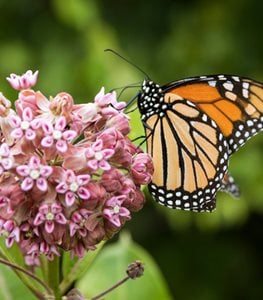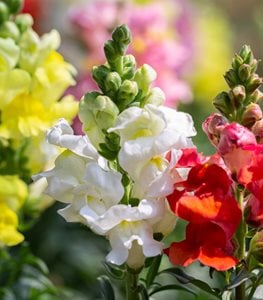25 BUTTERFLY GARDEN PLANTS & FLOWERS
Attract butterflies to your yard with these nutrient-rich plants and flowersWhen it comes to food sources for butterflies, not all plants are created equal. Through evolution, individual butterfly species became highly selective with the types of plants they feed on. While many plant varieties can attract butterflies, some are better than others for providing essential nutrients.
Adult butterflies and their offspring differ in the way they consume food. Adults drink through a long tubular tongue, relying solely on liquid sources such as flower nectar, tree sap, and fallen fruit. Butterfly larvae have chewing mouth parts, feeding on leafy food sources such as milkweed foliage, herbs, trees, and grasses.
By learning which plants and flowers are the best food sources, you can attract and support butterflies in your yard.
Read more about what it takes to create a beautiful butterfly garden that serves both adult butterflies and caterpillars.
ASTER (Symphotrichum)
Butterfly appeal: Among the most valuable butterfly plants, this North American native is a host plant for painted crescent and pearl crescent butterflies. Prolific daisy-like blooms are an essential late-season food source for migrating monarchs. Buckeyes, skippers, admirals, and painted ladies love the flowers, too.
Plant type: PerennialZones: 3-8
Bloom time: Summer to fall
Flower colors: Blue, pink, purple, white
Height: 1 to 6 feet tall
Read more about growing asters.
BEE BALM (Monarda)
Butterfly appeal: Tubular nectar-rich flowers are a food source for a wide range of pollinating insects and butterflies including checkered white, silver-spotted skipper, swallowtails, and fritillaries. A reliable long-lived perennial, bee balm grows in most regions and is virtually care-free.
Plant type: PerennialZones: 3-9
Bloom time: Summer
Flower colors: Red, pink, lavender, purple, white
Height: 1 to 4 feet tall
Read more about growing bee balm.
BLACK-EYED SUSAN (Rudbeckia)
Butterfly appeal: Native to open woodlands, prairies, meadows, and roadsides, this common wildflower has daisy-like flowers that appeal to many butterflies including great spangled fritillary, pearl crescent, silvery checkerspot, and spring azure.
Plant type: PerennialZones: 3-9
Bloom time: Summer
Flower colors: Bronze, gold, mahogany, orange, or yellow, with a dark center
Height: 1 to 4 feet tall
Read more about growing black-eyed Susan.
BLAZING STAR (Liatris)
Butterfly appeal: Also called gayfeather, this sturdy North American prairie native produces spiky flowers throughout summer which attract buckeyes, monarchs, swallowtails, and many other butterflies.
Plant type: PerennialZones: 3-9
Bloom time: Summer
Flower colors: Lavender, pink, purple, white
Height: 1 to 5 feet tall
Read more about growing blazing star.
BUTTERFLY BUSH (Buddleia)
Butterfly appeal: Butterfly bush is one of the top plants for attracting an array of butterflies, including various types of fritillaries, skippers, swallowtails, and painted lady. In areas where butterfly bush is invasive, non-seeding varieties may be substituted.
Plant type: ShrubZones: 5-9
Bloom time: Summer to early fall
Flower colors: Blue, pink, purple, white, yellow, bicolored
Height: 4 to 12 feet tall
Read more about growing butterfly bush.
BUTTON BUSH (Cephalanthus occidentalis)
Butterfly appeal: Showy fragrant flowers are a magnet for many species of butterflies including skippers, swallowtails, and monarchs. Button bush is also a host plant for several types of beneficial moths. Native to much of the U.S., this sturdy shrub is a good substitute in areas where butterfly bush is invasive.
Plant type: ShrubZones: 5-9
Bloom time: June to September
Flower colors: White
Height: 5 to 12 feet tall
CATMINT (Nepeta)
Butterfly appeal: This easy-care mint relative blooms over an exceptionally long time, making it a reliable season-long nectar source for many pollinators including hummingbirds, honeybees, and many types of butterflies.
Plant type: PerennialZones: 3-9
Bloom time: Late spring to fall
Flower colors: Blue, lavender, pink, purple, white, yellow
Height: 1 to 3 feet tall
Read more about growing catmint.
CONEFLOWER (Echinacea)
Butterfly appeal: Native to prairies, fields, and open woodlands of North America, coneflower attracts a variety of butterfly species, including monarchs and different types of swallowtails, skippers, fritillaries, and admirals.
Plant type: PerennialZones: 3-9
Bloom time: Summer to early fall
Flower colors: Pink, purple, white, yellow, orange, red, green, and bicolored
Height: 1 to 4 feet tall
Read more about growing coneflower.
EGYPTIAN STAR FLOWER (Pentas)
Butterfly appeal: Flower clusters bloom profusely all summer long, providing a consistent nectar source for a wide range of pollinators. Butterflies are especially attracted to the eye-catching star-shaped flowers.
Plant type: AnnualZones: 10-11, usually grown as an annual
Bloom time: Planting to frost
Flower colors: Red, pink, lavender, white
Height: 1 to 3 feet tall
Read more about growing Egyptian star flower.
FALSE INDIGO (Baptisia)
Butterfly appeal: Hardy in most regions, this prairie native is a host plant for California dogface and silver-spotted skipper larvae. Tall spiky flowers are an early season source of nectar for many species of adult butterflies.
Plant type: PerennialZones: 3-10
Bloom time: Late spring to early summer
Flower colors: Blue, burnt orange, chocolate, lavender, pink, purple, white, yellow
Height: 4 to 5 feet tall
Read more about growing false indigo.
FLOSS FLOWER (Ageratum)
Butterfly appeal: This old-fashioned heirloom has clusters of puffy flowers that are attractive to many species of adult butterflies. Exceptionally long blooming low-maintenance plants are useful in containers or beds.
Plant type: AnnualZones: 9-10, usually grown as an annual
Bloom time: Late spring to fall
Flower colors: Blue, lavender, pink, purple, red, white
Height: 4 to 36 inches tall
Read more about growing floss flower.
GOLDENROD (Solidago)
Butterfly appeal: A vigorous wildflower with showy plume-shaped flowers, goldenrod grows natively along roadsides, in open meadows and woodlands. The blooms are an important late season nectar source for many butterfly species including painted lady, monarch, viceroy, and red admiral. Newer goldenrod varieties such as ‘Fireworks’ are more compact and slower to spread.
Plant type: PerennialZones: 3-9
Bloom time: Late summer to fall
Flower colors: Yellow, white
Height: 1 to 6 feet tall
Read more about growing goldenrod.
HOLLYHOCK (Alcea)
Butterfly appeal: Large open-faced flowers appeal to a wide range of adult butterflies. This popular cottage garden staple is also a host plant for checkered skipper and painted lady caterpillars.
Plant type: Biennial or short-lived perennialZones: 3-8
Bloom time: Summer
Flower colors: Burgundy, chocolate, mauve, peach, pink, purple, red, white, yellow
Height: 2 to 8 feet tall
Read more about growing hollyhock.
JOE PYE WEED (Eutrochium)
Butterfly appeal: This moisture-loving Eastern US native grows wild in roadside ditches, streams, meadows, and woodlands. Large late-season flower plumes are a source of nectar for many butterflies including swallowtails and migrating monarchs.
Plant type: PerennialZones: 4-9
Bloom time: Mid-summer to fall
Flower colors: Pink, purple
Height: 3 to 8 feet tall
Read more about growing Joe Pye weed.
LANTANA / SHRUB VERBENA (Lantana)
Butterfly appeal: One of the best flowering plants for attracting a wide range of butterflies, shrub verbena blooms continuously during the time of year when adults are most active. Cabbage white, monarch, red admiral, skippers, and swallowtails are just a few of the many different butterflies that will feed on the delectable flowers.
Plant type: Tender perennial, usually grown as an annualZones: 9-11
Bloom time: Planting to frost
Flower colors: Single, bi- or multi-colored in hues of coral, orange, pink, purple, red, white, yellow
Height: 2 to 6 feet tall
Read more about growing lantana.
LAVENDER (Lavandula)
Butterfly appeal: Spiky aromatic flowers are a favorite summertime food source for adult butterflies including cabbage white, hairstreak, monarch, sachem, and silver-spotted skipper.
Plant type: PerennialZones: 5-9
Bloom time: Late spring to early fall
Flower colors: Blue, lavender, pink, purple, white
Height: 1 to 4 feet tall
Read more about growing lavender.
MILKWEED, BUTTERFLY WEED (Asclepias)
Butterfly appeal: One of the most essential butterfly plants, milkweed is the sole food source for monarch larvae. Home gardeners can play a crucial supporting role by providing a way station for these endangered migratory butterflies. Dozens of other species including various types of swallowtails, fritillaries, skippers, and admirals are also attracted to the colorful flowers.
Plant type: PerennialZones: 5-9
Bloom time: Summer
Flower colors: Pink, purple, orange, yellow, white
Height: 2 to 4 feet tall
Read more about growing milkweed.
PHLOX (Phlox)
Butterfly appeal: This large group of flowering plants, which comes in a range of flower colors, forms, and sizes, provides a reliable source of nectar. Clusters of long blooming star-shaped flowers appeal to many butterflies, including swallowtails, silvery checkerspot, and clouded sulfur.
Plant type: PerennialZones: 4-8
Bloom time: Summer
Flower colors: Blue, coral, orange, pink, plum, purple, red, white, yellow, bicolored
Height: 6 to 48 inches tall
Read more about growing phlox.
SAGE (Salvia)
Butterfly appeal: This mint relative with scented foliage is long-lived, reliable, and drought-tolerant. Spiky or tubular flowers appeal to many butterfly species including American lady, cabbage white, and different types of skippers, swallowtails, and sulfurs.
Plant type: PerennialZones: 4-12
Bloom time: Late spring to fall
Flower colors: Blue, coral, mauve, orange, pink, purple, red, yellow, white
Height: 1 to 5 feet tall
Read more about growing sage.
SHASTA DAISY (Leucanthemum superbum)
Butterfly appeal: A classic cottage garden staple, Shasta daisy is a host plant and nectar source for many butterfly species including painted lady, cabbage white, eastern tiger swallowtail, and red admiral.
Plant type: PerennialZones: 5-9
Bloom time: Early sumer to fall
Flower colors: White or pale yellow with a dark yellow center
Height: 6 to 48 inches tall
Read more about growing Shasta daisies.
SNAPDRAGON (Antirrhinum majus)
Butterfly appeal: This popular cottage garden variety is a host plant for common buckeye larvae. Tubular flowers come in a range of colors, appealing to many butterfly species such as cabbage white, grey hairstreak, pearl crescent, and swallowtail.
Plant type: PerennialZones: 7-11
Bloom time: Late spring to fall
Flower colors: Yellow, white, orange, red, pink, coral, purple, bicolored
Height: 6 to 48 inches tall
Read more about growing snapdragon flowers.
STONECROP (Sedum)
Butterfly appeal: This diverse group of carefree drought-tolerant plants is an important mid to late season source of nectar as well as a host plant. Groundcover and upright forms are suitable for rock gardens and curbside strips. American painted ladies, buckeyes, silver-spotted skippers, and many other butterfly species gravitate to the nectar-rich star-shaped flowers.
Plant type: PerennialZones: 3-8
Bloom time: Summer to fall
Flower colors: Pink, white, yellow, red, purple, orange
Height: 3 to 36 inches tall
Read more about growing stonecrop.
SUNFLOWER (Helianthus annuus)
Butterfly appeal: One of the most endearing signs of summer, sunflowers are attractive to a wide range of pollinators. These stately plants with large disk-shaped flowers are a host plant for streamside checkerspot butterfly, while the blooms are a rich nectar source for dozens of butterfly species including American lady, monarch, and various types of checkerspots and swallowtails.
Plant type: AnnualZones: 10-11, usually grown as an annual
Bloom time: Summer to fall
Flower colors: Yellow, white, red, brown, mahogany, orange; most with a brown or black center
Height: 3 to 10 feet tall
Read more about growing sunflowers.
YARROW (Achillea)
Butterfly appeal: Prolific clusters of brightly colored flowers make this a favorite nectar source of many butterflies, including American copper, Lorquin’s admiral, West Coast lady, and red-banded hairstreak.
Plant type: PerennialZones: 3-9
Bloom time: Summer to early fall
Flower colors: Yellow, red, purple, pink, coral, orange, white
Height: 1 to 4 feet tall
Read more about growing yarrow.
ZINNIA (Zinnia)
Butterfly appeal: Zinnias come in a rainbow of bright tropical hues that butterflies love. Use this cheerful warm-season bloomer in a border or kitchen garden to attract butterflies and bees, which will help pollinate edible crops. This easy-care annual will reward with months of continuous bloom.
Plant type: AnnualZones: 9-11, usually grown as an annual
Bloom time: Summer to fall
Flower colors: Red, orange, yellow, pink, peach, purple, white, green, bicolored
Height: 6 to 48 inches tall
Read more about growing zinnias.
RELATED:
30 Essential Plants for Pollinators
Perennials for Pollinators
Flowers for a Bee-Friendly Garden
How to Start a Flower Garden


























